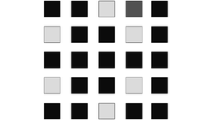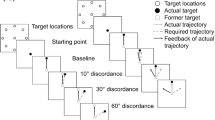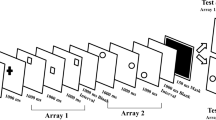Abstract
The directional accuracy of pointing arm movements to remembered targets in conditions of increasing memory load was investigated using a modified version of the Sternberg’s context-recall memory-scanning task. Series of 2, 3 or 4 targets (chosen randomly from a set of 16 targets around a central starting point in 2D space) were presented sequentially, followed by a cue target randomly selected from the series excluding the last one. The subject had to move to the location of the next target in the series. Correct movements were those that ended closer to the instructed target than any other target in the series while all other movements were considered as serial order errors. Increasing memory load resulted in a large decrease in the directional accuracy or equivalently in the directional information transmitted by the motor system. The constant directional error varied with target direction in a systematic fashion reproducing previous results and suggesting the same systematic distortion of the representation of direction in different memory delay tasks. The constant directional error was not altered by increasing memory load, contradicting our hypothesis that it might reflect a cognitive strategy for better remembering spatial locations in conditions of increasing uncertainty. Increasing memory load resulted in a linear increase of mean response time and variable directional error and a non-linear increase in the percentage of serial order errors. Also the percentage of serial order errors for the last presented target in the series was smaller (recency effect). The difference between serial order and directional spatial accuracy is supported by neurophysiological and functional anatomical evidence of working memory subsystems in the prefrontal cortex.



Similar content being viewed by others
References
Carpenter AF, Georgopoulos AP, Pellizzer G (1999) Motor cortical encoding of serial order in a context-recall task. Science 283:1752–1757
de Graaf JB, Sitting AC, Denier van der Gon JJ (1991) Misdirections in slow goal-directed arm movements and pointer-setting tasks. Exp Brain Res 84:434–438
de Graaf JB, Sitting AC, Denier van der Gon JJ (1994) Misdirections in slow, goal-directed arm movements are not primarily visually based. Exp Brain Res 99:464–472
Funahashi S, Inoue M, Kubota K (1997) Delay-period activity in the primate prefrontal cortex encoding multiple spatial positions and their order of presentation. Behav Brain Res 84:203–223
Georgopoulos AP, Lurito JT (1991) Cognitive spatial-motor processes. 6. Visuomotor memory scanning. Exp Brain Res 83:453–458
Georgopoulos AP, Massey JT (1988) Cognitive spatial-motor processes. 2. Information transmitted by the direction of two-dimensional arm movements and by neuronal populations in primate motor cortex and area 5. Exp Brain Res 69:315–326
Gourtzelidis P, Smyrnis N, Evdokimidis I, Balogh A (2001) Systematic errors of planar arm movements provide evidence for space categorization of multiple frames of reference. Exp Brain Res 139:59–69
Huttenlocher J, Hedges LV, Duncan S (1991) Categories and particulars: prototype effects in estimating spatial location. Psychol Rev 98:352–376
McIntyre J, Stratta F, Lacquaniti F (1997) Viewer-centered frame of reference for pointing to memorized targets in three-dimensional space. J Neurophysiol 78:1601–1618
McIntyre J, Stratta F, Lacquaniti F (1998) Short-term memory for reaching to visual targets: psychophysical evidence for body-centered reference frames. J Neurosci 18:8423–8435
Owen AM, Morris RG, Sahakian BJ, Polkey CE, Robbins TW (1996a) Double dissociations of memory and executive functions in working memory tasks following frontal lobe excisions, temporal lobe excisions or amygdalo-hippocampectomy in man. Brain 119:1597–1615
Owen AM, Evans AC, Petrides M (1996b) Evidence for a two-stage model of spatial working memory processing within the lateral frontal cortex: A positron emission tomography study. Cereb Cortex 6:31–38
Petrides M (1991) Functional specialization within the dorsolateral frontal cortex for serial order memory. Proc R Soc Lond B 246:299–306
Petrides M (1994) Frontal lobes and working memory: evidence from investigations of the effects of cortical excisions in nonhuman primates. In: Boller F, Grafman J (eds) Handbook of neuropsychology, vol. 9. Elsevier, Amsterdam, pp 59–82
Smyrnis N, Gourtzelidis P, Evdokimidis I (2000) Systematic directional error in 2-D arm movements increases with increasing delay between visual target presentation and movement execution. Exp Brain Res 131:111–120
Soechting HF (1984) Effect of target size on spatial and temporal characteristics of a pointing movement in man. Exp Brain Res 54:121–132
Soechting JF, Flanders M (1989) Sensorimotor representations for pointing to targets in three-dimensional space. J Neurophysiol 62:582–594
Sternberg S (1966) High-speed scanning in human memory. Science 153:652–654
Sternberg S (1969) Memory scanning mental processes revealed by reaction-time experiments. Am Sci 57:421–457
Sternberg S (1975) Memory scanning new findings and current controversies. Q J Exp Psychol 27:1–32
Author information
Authors and Affiliations
Corresponding author
Additional information
This work was supported by internal funding from Aeginition University Hospital
Rights and permissions
About this article
Cite this article
Theleritis, C., Smyrnis, N., Mantas, A. et al. The effects of increasing memory load on the directional accuracy of pointing movements to remembered targets. Exp Brain Res 157, 518–525 (2004). https://doi.org/10.1007/s00221-004-1865-6
Received:
Accepted:
Published:
Issue Date:
DOI: https://doi.org/10.1007/s00221-004-1865-6




